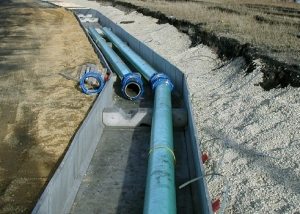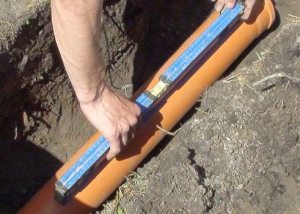The attitude of modern man towards the benefits of civilization has recently undergone significant changes. If 2-3 decades ago, the device at the cottage of a street toilet was considered quite normal, today many owners of private houses are equipping an autonomous system for discharging domestic wastewater. In addition to the laying technology, for this it is necessary to know what is the optimal depth of the sewer pipes in the region where the structure is located.
Content
Factors
The depth of laying sewage pipes in a private house depends on the terrain and the technical characteristics of the pipeline. The main ones are experts:
- soil freezing level. Below this mark, the moisture present in the soil does not turn into ice;
- level of the entry point to the septic tank or collector;
- the strength of the pipes themselves;
- degree of load on the pipeline. Low load is recorded in the usual local area and on the sidewalks. In the laying areas along which vehicles move, an increased load is observed.
In contrast to the methodology for designing water supply communications, the calculation of the laying depth of sewage pipes in a private house is carried out not by adding a certain distance to the freezing depth, but by means of a subtraction operation.
For example, if sewer pipes with a diameter of up to 0.5 m are laid, 0.3 m is subtracted from the freezing depth. That is, when the level of moisture to ice is at 1.30 m, the depth of the sewage pipes in a private house will be 1.30 -0.3 = 1 m. If a larger diameter pipe is laid, 0.5 m should be removed.
Helpful advice! It is impossible to dig a ditch of smaller depth. In order to reduce the cost of excavation, you can dig trenches as soon as possible, but you should not forget about the convenience of laying pipes.
Pipe selection
Today, few people use for laying sewage systems ceramic or cast iron products. They were replaced by plastic polyvinyl chloride and propylene pipes. Their popularity is due to the presence of the following advantages:
- lack of corrosion;
- simplicity of laying (light weight) and installation. Any owner of a private house can install plastic pipes on their own;
- microorganisms do not accumulate on the inner walls;
- affordable price.
In addition, such pipes are resistant to many aggressive substances, so you can use any sewer cleaning agent, and any special solutions to remove blockages in them are not required.
Depth of laying sewer pipes at the exit from the house and its slope
The value of these parameters is regulated by regulatory documents. So, in the corresponding SNiP it is indicated that the sewer pipe should exit the structure at a height of more than 30 cm from the regional average freezing depth of the soil. In this case, the minimum depth of the sewerage of a private house is considered to be 70 cm.
In most cases, the arrangement of an autonomous system for transporting domestic wastewater involves their gravity drainage by laying a pipe under a slope. The SNiP “Sewerage of buildings and internal water supply” states that if pipes with a diameter of up to 50 mm are used, the slope should be 3 cm per linear meter. When pipes with a diameter of 100 mm are buried, the value of this indicator is 2 cm.
If the above requirements are not met, the flow will move very slowly or, if the slope is very large, too fast. In the first case, the owner of a private house will encounter clogging of pipes: solid waste settling in them will interfere with the movement of effluents. The second installation option will lead to quick wear of the pipeline.

The calculation of the slope of the sewage system is carried out taking into account the diameter of the pipes
When laying pipes, it is necessary to check the slope using the building level, while the pipe must lie firmly on the ground.
Good to know! It is not necessary to make a bias if the drainage will be carried out by pumping, and not by gravity.
Depth of external sewage pipes
The importance of the correct choice of the depth of the sewage system is due to many factors. So, when the pipeline lies at the freezing level, the drains will cool, which will lead to the formation of congestion. As a result, it will become impossible to use sewage systems before warming. In addition, the minimum number of connections prevents the occurrence of congestion.
You should also know that, the fewer turns in the external system of domestic wastewater, the less likely it is that you need to tear off pipes in order to clean them. After all, the presence of bends has a direct effect on the throughput of the pipeline and the speed of movement of sewage. But if it is impossible to avoid turns, at the junction point it is necessary to make a well, which you can freely inspect at any time.
The easiest way to equip sewers is to use a septic tank. It is installed in a pit dug near the house. Moreover, its remoteness from the building should exceed 5 meters. And the recommended depth of immersion of the septic tank in the ground is one and a half meters. So that it does not overflow with groundwater and does not collapse under soil pressure, a concrete sarcophagus can be made in the pit.
When calculating at what depth it is necessary to dig a sewer pipe, taking into account only the depth of the septic tank and the level of freezing of the soil is not enough. Another important factor is the topography and structure of the soil on which the house is built.
For example, construction can be carried out on a slope. In this case, it would be logical to run down the sewer. But then the question arises: what should be the depth of the sewer pipe in a private house? Indeed, the fulfillment of the requirement that a slope of 2–3 cm must be observed throughout the pipeline may simply be impossible. In this case, you will have to dig a pipe very deep near the house. But, one way or another, distribution or overflow wells cannot be dispensed with. They will slow down the speed of movement of effluents to the treatment plant.
If you do not carry out the calculations, then very soon you will have to face the problem of the fast clogging of the drainage system or there will be a leak due to wear. The well of plastic, most likely, will also have to be insulated in order to seamlessly use the sewage system in severe cold.
You can find out the depth at which moisture present in the soil turns into ice using a special card. It is called: "Map of the depth of freezing of the soil." Having carefully studied it, you will determine what is the minimum permissible depth of sewage in your region.
For some large cities of the Russian Federation, below is a summary table of the depth of freezing of various soils.
Table 1
| City | Standard depth of freezing, meters. | |||
| Coarse soil | Sands of medium size, large | Fine and dusty sands | Loam, clay | |
| Moscow | 2,0 | 1,76 | 1,64 | 1,35 |
| St. Petersburg | 2,04 | 1,80 | 1,68 | 1,38 |
| Nizhny Novgorod | 2,20 | 1,94 | 1,81 | 1,49 |
| Novgorod | 1,82 | 1,60 | 1,49 | 1,22 |
| Vladimir | 2,12 | 1,87 | 1,75 | 1,44 |
Installation
Having decided on the depth of the sewage in a private house, you can start laying the pipeline.
First you need to dig a trench. At the bottom, without fail, pour a pillow of a mixture of sand and clay. The pillow simultaneously performs two functions: a heat insulator and a kind of shock absorber for the pipeline being laid. If necessary, you can use additional pipe insulationif the depth is small or the soil freezes very deep.
Important! If for one reason or another it is impossible to create the required laying depth, the pipe should be insulated. To do this, you can use mineral wool and other materials with similar characteristics.
The space between the walls of the trench and the pipe is also covered with a mixture of sand and clay. Do not bury the pipe with previously extracted soil. To do this, use the same mixture. After filling the pipe, compact the top layer tightly. So you prevent the deformation of the pipeline. As mentioned above, in the places of its rotation it is necessary to leave manholes that are designed to eliminate blockages and diagnose the condition of the pipeline as a whole. To equip their walls, you can use reinforced concrete rings or old brick. Dimensions of the structure depend on the depth of the sewage system of a private house.
Properly calculated laying depth guarantees the longest possible operation of the sewer pipeline, the absence of the slightest problems and impeccable functionality.











